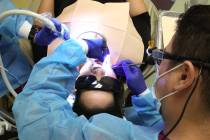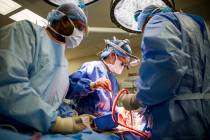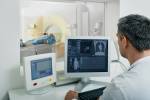Cellphone radiation raises concerns
Better to be safe than sorry.
You’ve heard that expression a million times.
Given that it’s Breast Cancer Awareness Month, Dr. Paul Michael, of Comprehensive Cancer Centers of Nevada, wants you to hear it again in relation to cellphones and the disease that still strikes more than 230,000 women each year.
Even though he stresses serious research on cellphone radiation and breast cancer is in its infancy and there is no conclusive evidence linking the two, the former American Cancer Society board member says “it’s not a good idea” for anyone concerned about getting the disease to risk doing what many young women consider hip today — tucking an active cellphone into their bra while they drive, jog, shop or sit in movie theaters.
For years, he said, scientists have been studying — basically in relation to brain cancer — the form of energy given off by cellphones known as radiofrequency waves, a type of nonionizing radiation that the International Agency for Research on Cancer has classified as “possibly carcinogenic to humans.”
Because all expert agencies agree that evidence of a possible link between cellphones and cancer is limited and more research is needed to look at possible long term effects — a kind of “maybe” conclusion that often becomes easy for some to dismiss — Michael suggested that warnings by cellphone manufacturers themselves should make women more cautious about where they carry and use cellphones.
“They put in their instruction manuals that people shouldn’t have the phones touching them,” he said.
It’s in the fine print, but it’s there. An Apple iPhone 4 warning reads: “When using iPhone near your body for voice calls or for wireless data transmission over a cellular network, keep iPhone at least 15 mm (5/8 inch) away from the body, and only use carrying cases, belt clips or holders that do not have metal parts and that maintain at least 15 mm (5/8 inch) separation between iPhone and the body.”
If that distance isn’t kept, the warning continues, “guidelines for self-exposure can be exceeded.”
(Apple spokesmen have consistently noted that the iPhone’s radio-frequency energy is well within the limits set by the Federal Communications Commission and governing agencies of other countries.)
Motorola warns W180 phone users to keep the active device one full inch away from their body, if not using a company approved “clip holder, holster, case or body harness.”
What has caused cancer prevention activists to start looking more at possible linkage between cellphones and breast cancer is the work of Devra Davis, the founding director of the center for environmental oncology at the University of Pittsburgh Cancer Institute as well as the founder of Environmental Health Trust and the author of “DISCONNECT: The Truth About Cellphone Radiation.”
“Experimental studies show that cellphone radiation accelerates the growth of breast cancer cells,” she wrote.
Davis supports women using a headset or speakerphone with a cellphone, which the American Cancer Society says substantially reduces radiation exposure, as does holding a cellphone away from the body.
As she pushes for more research, Davis shares the stories of women, including Tiffany Frantz of Pennsylvania, who says she developed breast cancer at a spot where she kept her cellphone in her bra against her bare skin 12 hours a day. At 21, she underwent a mastectomy on her left breast.
Though he admits that what he calls “anecdotal evidence” can be powerful, medical oncologist Michael won’t allow himself to say there is a definite linkage between breast cancer and cellphones carried in bras.
That connection, he said, can only be definitively made with a study that follows many women.
Still, in the absence of scientific proof, Michael understands that what happened to Frantz and others like her may cause parents to caution their daughters about where they’re carrying their cellphones.
That, he said, would be a good thing.
“I don’t know if cellphones carried next to the breast cause cancer,” he said. “Not all radiofrequency waves cause cancer. But I do know from a recent study that young women are getting more aggressive and larger tumors than older women. Is that because of diet, pollution, cellphones or whatever? I don’t know. But we also know the people who make cellphones say they shouldn’t be carried that way. I think we know enough about this to say it’s better to be safe than sorry when it comes to where you’re carrying your cellphone.”
Paul Harasim is the medical writer for the Las Vegas Review-Journal. His column appears Mondays. Harasim can be reached at pharasim@reviewjournal.com or 702-387-2908.























